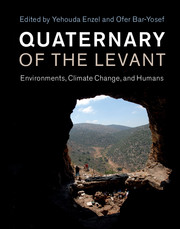Book contents
- Quaternary of the Levant
- Quaternary of the Levant
- Copyright page
- Contents
- Contributors
- Acknowledgements
- 1 The Quaternary of the Levant
- Part I: The Evolution of Current Landscapes and Basins
- Part II: Palaeoclimates
- Part III: Archaeology of Human Evolution
- Part IV: Palaeoecology
- 38 Palaeolithic Vegetal Diet in the Southern Levant
- 39 Pollen as Palaeoclimate Indicators in the Levant
- 40 The Archaeozoological Record in a Changing Environment of the Late Middle to the Late Pleistocene
- 41 Biogeography and Palaeoecology of the Early Pleistocene Large Mammals in the Levant
- 42 The Kaleidoscope of Mammalian Faunas during the Terminal Pleistocene and Holocene in the Southern Levant
- 43 Fish Exploitation during the Quaternary
- 44 The Exploitation of Aquatic Resources during the Quaternary
- 45 Fossil-Based Reconstructions of Ancient Water Bodies in the Levantine Deserts
- Part V: Quaternary Geomorphology
- Part VI: Humans in the Levant
- Index
- Plate section
- References
44 - The Exploitation of Aquatic Resources during the Quaternary
from Part IV: - Palaeoecology
Published online by Cambridge University Press: 04 May 2017
- Quaternary of the Levant
- Quaternary of the Levant
- Copyright page
- Contents
- Contributors
- Acknowledgements
- 1 The Quaternary of the Levant
- Part I: The Evolution of Current Landscapes and Basins
- Part II: Palaeoclimates
- Part III: Archaeology of Human Evolution
- Part IV: Palaeoecology
- 38 Palaeolithic Vegetal Diet in the Southern Levant
- 39 Pollen as Palaeoclimate Indicators in the Levant
- 40 The Archaeozoological Record in a Changing Environment of the Late Middle to the Late Pleistocene
- 41 Biogeography and Palaeoecology of the Early Pleistocene Large Mammals in the Levant
- 42 The Kaleidoscope of Mammalian Faunas during the Terminal Pleistocene and Holocene in the Southern Levant
- 43 Fish Exploitation during the Quaternary
- 44 The Exploitation of Aquatic Resources during the Quaternary
- 45 Fossil-Based Reconstructions of Ancient Water Bodies in the Levantine Deserts
- Part V: Quaternary Geomorphology
- Part VI: Humans in the Levant
- Index
- Plate section
- References
Summary
- Type
- Chapter
- Information
- Quaternary of the LevantEnvironments, Climate Change, and Humans, pp. 377 - 380Publisher: Cambridge University PressPrint publication year: 2017
References
- 1
- Cited by

